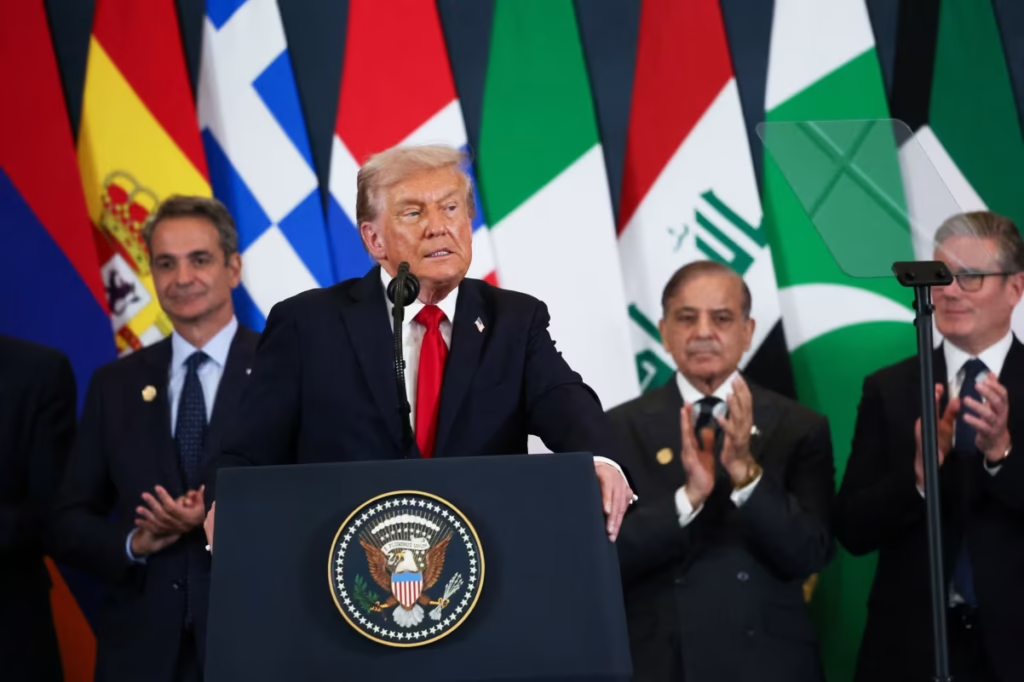Fresh off a fragile ceasefire-and-hostage agreement in the Middle East, President Donald Trump is signaling that he wants to export the momentum to other world crises — starting with Russia’s war in Ukraine. Whether that’s realistic remains an open question across Washington and Europe.
From Gaza to Global Ambitions
On Monday, Trump sat in the gallery of Israel’s parliament, the Knesset, listening as lawmakers praised the ceasefire deal that freed dozens of hostages from Hamas. During the visit, he turned to his special envoy for peace missions, real estate developer Steve Witkoff, and gave him his next target.
“We have to get Russia done… let’s focus on Russia first,” Trump said, according to people in the room.
The president, energized by what he is calling a historic Middle East success, is betting that diplomatic momentum works the same way it does in politics — one win leading to the next. His week stretched from a 36-hour sprint through the region to a tense lunch with Ukrainian President Volodymyr Zelensky at the White House.
In the span of several days, Trump:
confirmed he had authorized covert CIA operations in Venezuela,
endorsed Argentina’s new nationalist leader along with a $20 billion U.S. economic aid package,
floated fresh tariff threats against China ahead of a coming meeting with Xi Jinping.
“I think we carry a lot of momentum, a lot of credibility,” Trump told Zelensky at the Cabinet Room lunch. “Nobody thought the Middle East could get done, and we got it done.”
Ceasefire Worries Linger
The deal in Gaza is far from permanent. Israeli officials expressed anger this week after Hamas failed to produce the remains of more than a dozen hostages presumed dead. U.S. officials say the group may not have the equipment or access needed to recover bodies from devastated areas of Gaza.
Trump’s advisers argue that the priority was retrieving the 20 living hostages, which they say Hamas honored. Witkoff and Jared Kushner have been tasked with keeping the truce alive and coordinating with third-party nations, including Turkey, to locate the remaining bodies.
The U.S. is pushing ahead with next steps: a multinational security force in Gaza and early planning for reconstruction. But unresolved questions — who governs Gaza, disarming Hamas, and the future of a Palestinian state — are still wide open.
Ukraine Pressure and a Putin Meeting
Trump appears to believe that moving quickly, even with unfinished details, is a virtue. He has already agreed to meet Vladimir Putin in Budapest in the coming weeks for face-to-face talks. That meeting is expected to come before his scheduled summit with Xi Jinping in South Korea.
European officials are skeptical. Unlike Israel, Russia and China aren’t dependent on U.S. military aid or financial backing. Some diplomats say Trump would need leverage — new sanctions or advanced weapons for Ukraine — to force Moscow to negotiate seriously. So far, he hasn’t applied either.
For a moment this week, Ukraine thought that might change.
Zelensky arrived in Washington lobbying hard for long-range Tomahawk missiles, manufactured by Raytheon, that could put Moscow within striking range. He met with company officials in anticipation of White House approval.
But over lunch, Trump made clear those weapons were off the table — at least for now.
“Hopefully they won’t need it,” he said. “Hopefully we’ll be able to get the war over without thinking about Tomahawks.”
Officials familiar with the private session described the conversation as tense, blunt and at times “uncomfortable.” Zelensky agreed not to raise the missile issue publicly.
Later, as Trump flew to Palm Beach, he posted online that Russia and Ukraine should end the war “where they are,” signaling openness to territorial concessions — a view he has toggled on and off in recent months.
Putin’s Influence Still Complicates the Picture
Trump’s reluctance to escalate comes as Putin continues to insert himself directly into the diplomatic process. A Kremlin-initiated phone call on the eve of Zelensky’s visit helped secure plans for the upcoming Hungary meeting.
That dynamic — warming to tougher steps before backing away when Putin engages — has been seen before. It has left some of Trump’s own advisers wondering if Moscow is simply buying time.
Trump says he’s aware of that risk.
“I’ve been played all my life by the best of them,” he said when asked about Putin’s intentions. “And I came out really well.”
Can Momentum Translate?
Trump insists that a breakthrough in Gaza has adjusted the global perception of American power under his watch. Some U.S. officials think Moscow may be recalculating, if only to test whether a deal is possible. Others believe Putin has little incentive to strike a deal without concessions he hasn’t yet secured — including limits on NATO aid and Ukrainian territory.
Complicating matters further, the Kremlin’s alliance with Beijing has deepened, with China helping cushion Russia’s economy through energy purchases and military supplies. Trump has suggested the Ukraine conflict could be resolved before he meets Xi at the end of the month.
His confidence is high — but it was high before his August summit with Putin in Alaska, too. That meeting ended without progress.
For now, Trump is embracing a strategy heavy on speed, personal diplomacy and political instinct — the same blend he used in Israel. Whether it works on Putin, who doesn’t face the same domestic pressures as Netanyahu, remains unclear.
As one European diplomat put it privately this week: “A ceasefire in Gaza doesn’t change the map in Ukraine.”

